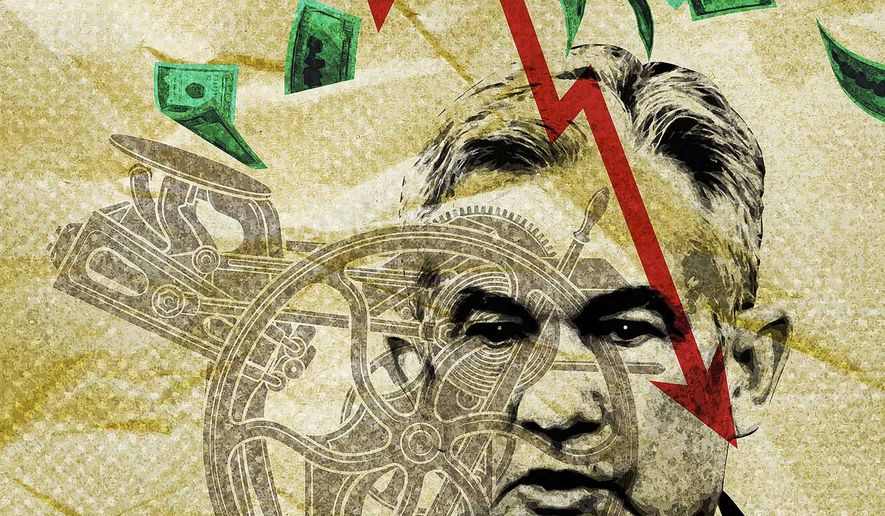OPINION:
President Biden scored a political victory with the passage of the American Recovery Act (ARA) — despite Republican protestations, the $1.9 trillion package enjoys 75% public approval.
Buying love is not hard. The ARA delivers on Mr. Biden’s promise to send most Americans stimulus checks during the Georgia senatorial runoff elections. It’s full of payoffs to reliable Democratic constituencies — bailouts for poorly run states and union pensions, and money for universities and the arts — having little to do with the pandemic.
Unfortunately for Mr. Biden, Democrats will be more difficult to unite, Republicans quite hard to persuade and the Federal Reserve much less helpful for his next round of spending to Build Back Better.
The price tag to repair America’s infrastructure and electrical grid, accelerate the buildout of windmills, solar power and electric vehicles, lessen inequality by making permanent the ARA’s one-year boost to the child, dependent care and earned income tax credits and food stamps, harden supply chains for medical equipment and semiconductors, and boost R&D to meet the China challenge will require at least $1 trillion a year.
The federal deficit was $3.1 trillion in 2020 or about 15% of GDP. Prior to the year end $900 billion stimulus package and the ARA, the deficit for 2021 was on track to be a bit less than $1 trillion. Now the deficit is projected to be $3.4 trillion and $1.6 trillion next. Add to that another $1 trillion or so annually for Build Back Better, and we are running huge deficits for as far as the eye can see.
That’s a lot of bonds to sell.
Each month, the Fed prints money to buy Treasury, mortgage-backed and other securities. During the pandemic, it printed as much money as needed to finance the $3.1 trillion deficit and push the rate on 10-year Treasuries below 1%.
We didn’t get much new inflation for goods and services, because most folks were shut in to avoid COVID-19 and the economy was terribly depressed.
Households used stimulus checks to paydown debt, build cash reserves and invest. The latter caused asset price inflation. Last year, stocks jumped 16% and existing home prices increased 14%.
With herd immunity within sight and the economy headed to max capacity by summer, the Fed has a binary choice. It can tolerate households spending more of their cash stashes to boost inflation or turn down the dial on its money-printing machine.
Federal Reserve Chairman Jerome Powell tells us he expects a temporary surge in prices but not an inflationary spiral and is determined to keep the money flowing to get to full employment,
The latter will be tough, because some 10 million workers either have permanently lost their jobs or are involuntarily stuck in part-time work. Their employers in the hospitality, airline, amusement and other industries are not coming back to pre-pandemic levels, and the economy would need a lot of excess demand and inflation to negate that reality.
Mr. Powell’s actions belie his words. The 10-year Treasuries rate is rising, because he’s not buying nearly so many bonds this year. That’s monetary tightening — big time.
The 10-year Treasury rate is much more important to the rates charged on mortgages, auto and student loans and credit cards than the overnight bank borrowing rate the Fed advertises as its policy rate and has kept near zero since March 2020.
As the months wear on, unemployment — especially U6, which includes folks working part-time that can’t find full time positions and those not currently looking that don’t believe they could find a good job — will remain stubbornly high.
You will see the sweat forming on Messrs. Biden’s and Schumer’s brows as they contemplate the mid-terms.
Pressure will build for another big reconciliation bill but that first requires the House and Senate to pass identical budget resolutions. As much of the hard left’s agenda in Congress — for example, the push to cut defense spending by 10% — does not enjoy 50-vote support in the Senate or even majority support in the House, that ballet will be more like the rumble in “West Side Story” than “Swan Lake.” Crafting a budget deal will get ugly.
High interest rates will slow the recovery, but not enough to stave off inflation, Democrats squabbling over an $80 billion defense spending cut after spending nearly $2 trillion to buy votes will be entertaining.
Senate Minority Leader Mitch McConnell may not have to say much in 2022 — the Democrats’ handiwork and infighting will do the campaigning for him.
• Peter Morici, @pmorici1, is an economist and emeritus business professor at the University of Maryland, and a national columnist.




Please read our comment policy before commenting.